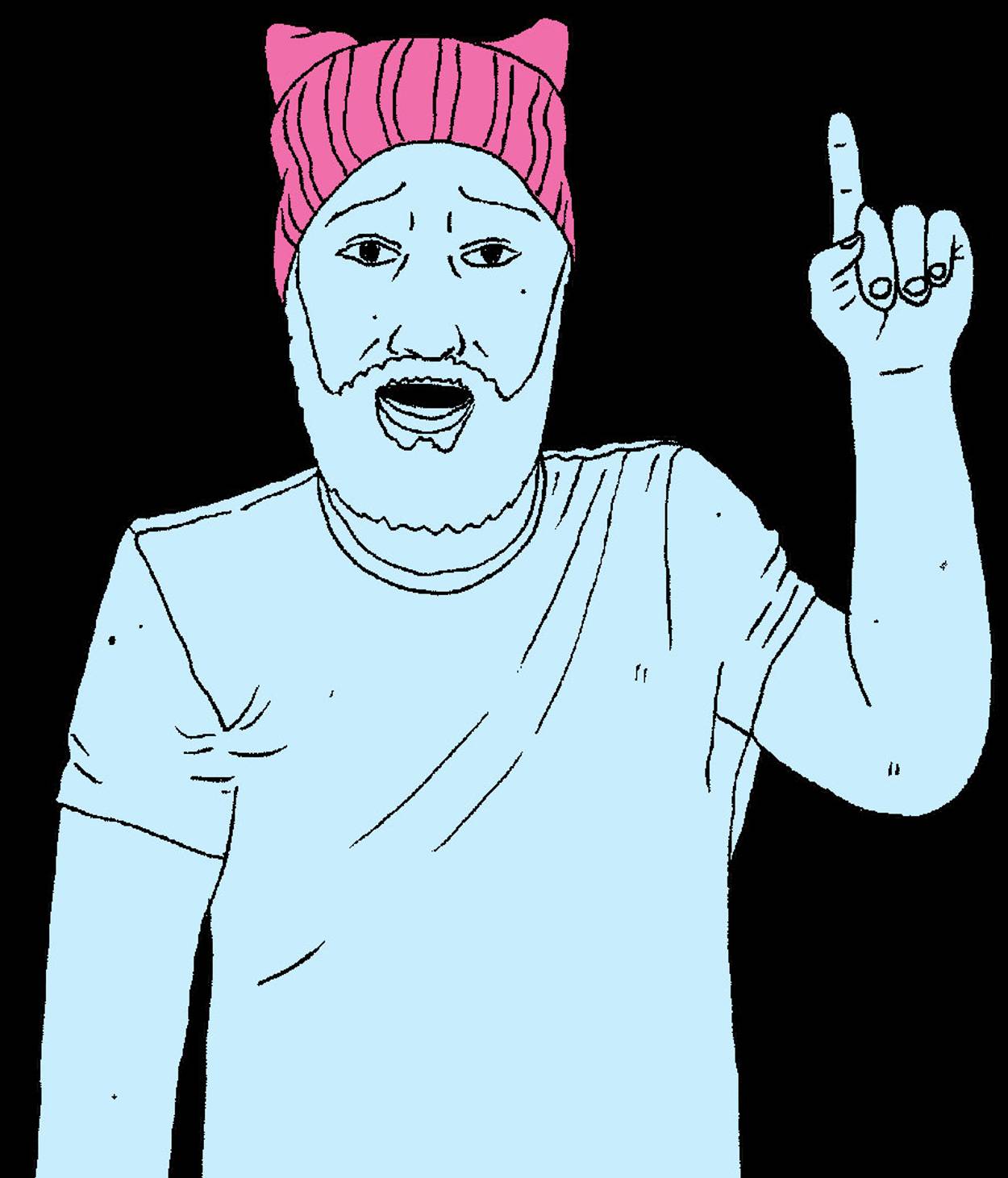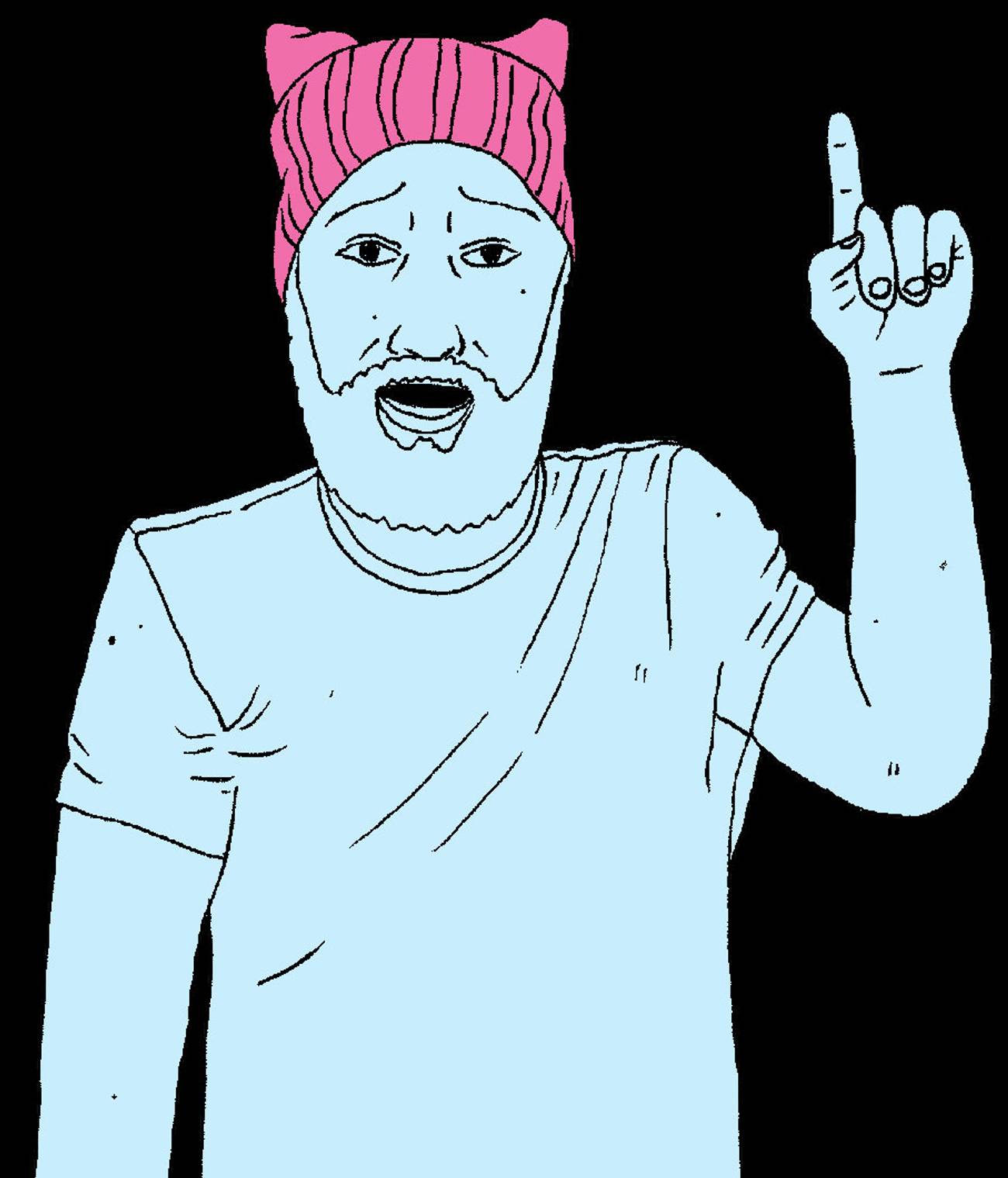Birth of the Cool Guy
What lies beneath the surface of his performative feminism?




In 2012, Gillian Flynn’s novel Gone Girl was a massive bestselling hit, inaugurating a new and still-thriving era of thrillers with the word “girl” in the title. But that’s only one half of the book’s cultural legacy; the other is an iconic passage in which Flynn’s anti-heroine, Amy Dunne, goes on a lengthy rant about the phenomenon of the so-called Cool Girl:
Being the Cool Girl means I am a hot, brilliant, funny woman who adores football, poker, dirty jokes, and burping, who plays video games, drinks cheap beer, loves threesomes and anal sex, and jams hot dogs and hamburgers into her mouth like she’s hosting the world’s biggest culinary gang bang while somehow maintaining a size 2, because Cool Girls are above all hot. Hot and understanding. Cool Girls never get angry; they only smile in a chagrined, loving manner and let their men do whatever they want. Go ahead, shit on me, I don’t mind, I’m the Cool Girl.
The Cool Girl was a stock character of the early aughts (as well as an actual character in movies like There’s Something About Mary.) And at least in the context of Flynn’s novel, the Cool Girl was understood as an explicitly female phenomenon—a desperate pretender trying to land a man. Insofar as she imagined a future where the tables were turned, Amy could only envision the Cool Girl’s male counterpart as a panderer in the same vein, guys who would “learn how to knit, pretend to love cosmos, organize scrapbook parties, and make out with each other while we leer.”
But that was never going to happen. Amy Dunne, in addition to being a sociopath, missed the power play lurking at the heart of Cool Girl culture: The raunch posturing was less about performing masculinity, and more about rejecting womanhood in a calculated ploy to get a little closer to the people in power. If bro culture was the ruling trend, then the Cool Girl’s self-degradation was a genius means of cozying up to the patriarchy, infiltrating the boys’ club, and enjoying the protection and nominal influence of that position. The Cool Girl isn’t really one of the guys; she’s just Not Like Those Other Girls.
The cosmo-drinking, scrapbooking women of the world never achieved the kind of clout to inspire a corresponding movement of approval-craving men. But seven years after Gone Girl, as the #MeToo movement reshapes power dynamics and remakes social norms, the Cool Guys are finally here—peacocking for feminism with all the same performative vigor.
Cool Guy doesn’t knit, but he definitely owns a pink pussy hat (ordered from a female artist on Etsy, as he’ll conspicuously let you know). When he’s not tweeting about toxic masculinity, he’s hanging out in the replies on feminist threads, apologizing on behalf of all men everywhere for being such trash. Cool Guy writes a several-thousand-word New York Times op-ed flagellating himself for having ogled the butts of his teenage classmates once upon a time, in a quest to ignite a public movement of male confession with himself at its center (suggested hashtag: #IAmSexist)—or just fantasizes about a world where women have all the power and men simply cease to exist. And of course, Cool Guy believes women, so when he’s outed for sexual misconduct himself, he makes sure to let everyone know how happy he is to be the bigger person and throw himself under the bus for the movement. James Franco, in the wake of his #MeToo moment, said, “There are people that need to be heard. I have my own side of this story, but I believe in these people that have been underrepresented getting their stories out enough that I will hold back things that I could say just because I believe in it that much.”
I could say these women are liars, says the Cool Guy. But I won’t. (Subtext: But they are!) He’s bigger than that: a martyr taking one for the team, because feminism is that important to him. Maintaining his innocence, or trying to clear his name? He would never. That’s for MRA types!
Go ahead, shit on me; I’m the Cool Guy.
This breed of performative male feminism can take many forms, but implicit in it is the same sensibility that animated the conspicuously low-maintenance Cool Girl. When one of these guys says men are trash, he doesn’t mean himself. Even if he nominally claims to still be “unlearning” his own bad ideological habits, he’s not like those other guys, not one of the bad men. He’s “half woke,” a step above the rest, one of the good ones, or—on certain curious occasions—not actually a man at all. Last year, Peter Coffin, a bearded, male-presenting feminist, came out publicly as nonbinary because “I am physically happy with myself but severely dislike my place in the gender dynamic.” In fact, Coffin wrote, “it just felt like the dynamic didn’t apply to me.” Ignoring the fact that Coffin still reads as male to the world at large (and will continue to reap the accompanying benefits of such, whatever they might be), it’s not hard to see the reasoning: Men are Bad. I am Not Bad. Hence, I am Not a Man.
Either way—whether he’s disavowing masculinity entirely or only distancing himself from it—the Cool Guy’s performance inches him incrementally closer to the new nexus of cultural power. And yes, it sometimes puts him in contact with women who find his posturing attractive, but here the analogy frays: Cool Guys are not, above all, hot, nor is that their primary intention. Where Amy Dunne imagines grabbing an enraptured man by the lapels and telling him what’s what—“Nobody likes chili dogs that much!”—many women, and particularly the longtime feminists from whom the Cool Guy borrows his talking points, find him insincere and obnoxious. Even the women who date these men describe being attracted not to the behavior itself, but to the appearance of allyship, a guy they won’t have to explain male privilege to because he already gets it. It’s not that this self-flagellating male feminism is sexy, but it does seem safe. Surely, that guy won’t mistreat a woman the way a less-enlightened man might.
Except, of course, that they do. Scratch the surface of the Cool Guy’s self-conscious cheerleading, and there’s often something ugly underneath. You need only look at the way these men, who claim to respect and revere women, react when challenged by one—or at how they treat their girlfriends. The exposure of prominent male feminists as hypocritical jerks in their private lives happens so often that it’s not just a familiar narrative, but an SNL punchline.
So what defines the Cool Guy? It might be that Cool Guys are, above all, useless. It’s not just the convenient impossibility of their proposed solutions (it’s easy to make noise about dragging men into the sea or establishing a worldwide matriarchy when you’re utterly secure in the knowledge that neither of these things would ever happen.) It’s not even the way they abdicate a unique opportunity to address these issues in male spaces, choosing instead to indulge in empty self-promotional misandry that other men find either pathetic or alienating. These men push their way into the spotlight, making their self-aggrandizing martyrdom the main event, making a naked play for influence at the expense of women’s voices, and condescending to them in the process. The narrative they push, of women oppressed and in need of rescuing, is inherently disempowering. And when they bash the members of their sex as terrible or predatory by nature, they’re hardly telling the truth about men in general; too often, they’re just telling on themselves. That Cool Guys keep turning out to be bad guys follows a certain logic, what Tablet’s Phoebe Maltz Bovy identifies as “that gut sense … that a dude so proud of publicly checking his male privilege and so aware of why women might fear men, was a man women have reason to fear.”
Men who feel lost in this moment should not despair. It is entirely possible for them to be productive feminists by supporting, mentoring, and promoting women at work; voting for policies that give them equal footing in the eyes of the law; and dividing domestic duties equitably in their own homes. Indeed, anyone can do this—and many men do, including the men you’d least expect. (It’s an uncomfortable truth that Brett Kavanaugh, who may or may not have attempted a sexual assault in high school, nevertheless demonstrably—and without fanfare—promoted and supported women throughout his career in a way that made an objectively greater impact than any tweet thread.) The Cool Guy’s relentless pontificating doesn’t help women, and vitally, the degradation, disappearance, or death of men isn’t what feminists want. The goal of the movement has always been to normalize the not-actually-radical-at-all notion that women are people.
That’s a problem for the performative male feminists of the world, because treating women like people isn’t glamorous. It isn’t heroic.
It also isn’t that hard.
Like the Cool Girl phenomenon, the empty bluster of the performing male feminist will probably burn itself out in time—or come to an abrupt end when one Cool Guy too many gets exposed as an overcompensating, behind-the-scenes jerk. In the meantime, men who want to support gender equality will hopefully look to better guides.
Kat Rosenfield is a culture writer and novelist. Her next book, No One Will Miss Her, will be published by William Morrow in October 2021.